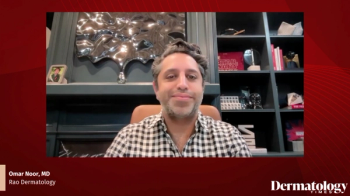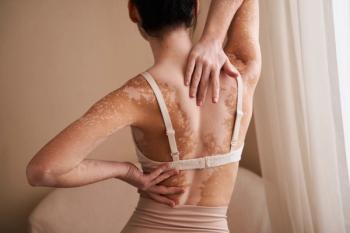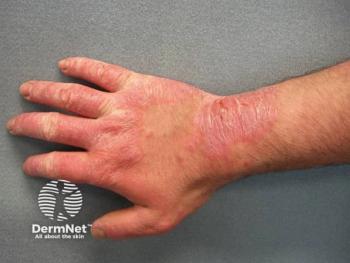
- Dermatology Times, September 2025 (Vol. 46. No. 09)
- Volume 46
- Issue 09
Experts Compare Real-World Use of Emerging AD Treatments
Key Takeaways
- Quality of life, including sleep and daily function, is prioritized over body surface area in treatment decisions for atopic dermatitis.
- New non-steroidal topicals like ruxolitinib cream are increasingly used for high-impact areas, especially in steroid-averse patients.
Clinicians explore innovative strategies for managing atopic dermatitis, emphasizing personalized care and the use of non-steroidal treatments for improved patient outcomes.
Atopic dermatitis (AD) continues to challenge clinicians with its heterogeneous presentation, unpredictable flares, and variable treatment responses. At a recent Dermatology Times Community Case Forum, Alexandria Golant, MD, of Mount Sinai, led an interactive discussion among clincians on optimizing topical therapy in patients who have exhausted traditional options or require individualized care approaches. The panel’s conversation revolved around 3 patient cases, each illustrating different therapeutic decision points.
Case 1: Man with Persistent Moderate AD
The first patient was a 34-year-old man with AD since childhood, presenting with approximately 10% body surface area (BSA) involvement, worsening flares, and severe itch affecting sleep and work performance. He had used medium-potency topical corticosteroids (TCS) with partial success and had been transitioned to topical tacrolimus without improvement.
Panelists emphasized that BSA alone is not the defining metric for severity. As one participant noted, “I don’t really care too much about BSA — I’m more about how much this is impacting the person’s quality of life.” Sleep disruption, clothing choices, and work limitations were considered critical in guiding treatment intensity.
Given his disease persistence despite TCS and calcineurin inhibitors, the group discussed newer non-steroidal options such as topical ruxolitinib cream. Golant pointed out its rapid onset and depth of itch relief, with phase 2 data suggesting it can match or exceed triamcinolone’s efficacy in certain endpoints. Several clinicians reported using ruxolitinib preferentially for localized, high-impact sites: “Love it for hand eczema,” one panelist shared, citing both speed and tolerability.
Case 2: Teen with Refractory Head and Neck AD
The second case involved a 15-year-old girl with chronic AD since age 2, predominately affecting her face and neck. She had tried multiple topical steroids, tacrolimus, and crisaborole (discontinued due to burning) but continued to flare after discontinuation.
Facial AD raised additional therapeutic and cosmetic considerations. One clinician commented, “For eyelids and face, I’m not going to use a potent steroid — I go right to a non-steroidal.” ruxolitinib cream was often favored for this region due to efficacy and safety in sensitive areas, although access and sample availability were common barriers.
The panel discussed lifestyle factors and potential contact triggers, from cosmetics to occupational exposures, and stressed that proactive, maintenance-based regimens could extend remission. As one participant noted, “Don’t wait for it to get bad — treat hotspots a couple of times a week to keep control.”
For this patient, escalation to a biologic such as dupilumab was considered, but her injection hesitancy led to trying tapinarof cream once daily, illustrating the importance of shared decision-making.
Case 3: Pediatric AD with Nocturnal Itch
The final case centered on an 8-year-old boy with primarily flexural AD and severe nighttime scratching, affecting the whole family’s sleep. He had partial relief with TCS and topical calcineurin inhibitors (TCIs) but ongoing symptoms.
Management in children under 12 was discussed in light of emerging topical JAK inhibitor data. In a pediatric trial, both 0.75% and 1.5% ruxolitinib creams showed significant Investigator’s Global Assessment success rates by week 8, with maintained response over 52 weeks when used reactively for flares.
If approved for younger children, several panelists indicated they would integrate topical ruxolitinib early in the treatment algorithm — especially for needle-averse patients or those with localized high-impact areas. “I’d offer ruxolitinib (Opzelura; Incyte), dupilumab (Dupixent; Sanofi and Regeneron), or even upadacitinib (Rinvoq; AbbVie) if a pill was preferred — and let the family choose what feels right,” one pediatric dermatologist said, describing her “menu” approach to shared decision-making.
Themes Across Cases
Quality of Life as a Core Metric
Across all cases, the panel agreed that quality of life (QOL) — including sleep, daily function, and psychosocial impact — outweighs BSA in guiding escalation. As one clinician summarized, “Goals aren’t always clearance; sometimes they’re comfort and normal daily activities.”
Personalized Treatment “Buckets”
Rather than rigid severity categories, many providers mentally sort patients into topical, systemic, or overlap “buckets” depending on history, preferences, and practicality. Occupational and lifestyle constraints often dictated whether a patient could adhere to frequent topical applications.
Non-Steroidal Topicals in High-Impact Areas
While TCS remain first-line for most, newer agents like ruxolitinib cream, roflumilast, and tapinarof are increasingly used first-line in steroid-averse patients or for sensitive areas such as the face, neck, hands, feet, and genitalia. Cost, access, and insurance step edits remain common barriers.
Proactive Maintenance
Multiple panelists advocated for scheduled maintenance therapy on recurrent sites to prolong remission, particularly in chronic, relapsing patients. This was seen as key in both adults and children.
Shared Decision-Making
Patients and caregivers were consistently offered multiple treatment options, with clinicians acting as “guides” rather than prescribers dictating a single path. This approach improved adherence and satisfaction, especially in pediatric care.
Conclusion
The roundtable underscored that managing AD with topicals in 2025 is both more complex and more flexible than ever. Clinicians now have multiple effective, non-steroidal agents to complement or replace corticosteroids in select scenarios. Success hinges on aligning therapy choice with patient lifestyle, preferences, and QOL priorities — whether that means introducing a fast-acting JAK cream for recalcitrant itch, adjusting vehicle formulations for tolerability, or proactively maintaining remission in high-impact areas.
Articles in this issue
2 months ago
Dermatology Times September 2025 Print Recap2 months ago
Cosmeceutical Myths3 months ago
Research-Inspired Tips From DERM 20253 months ago
Balancing Cure and Cosmesis in Mohs SurgeryNewsletter
Like what you’re reading? Subscribe to Dermatology Times for weekly updates on therapies, innovations, and real-world practice tips.



















